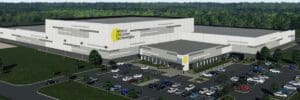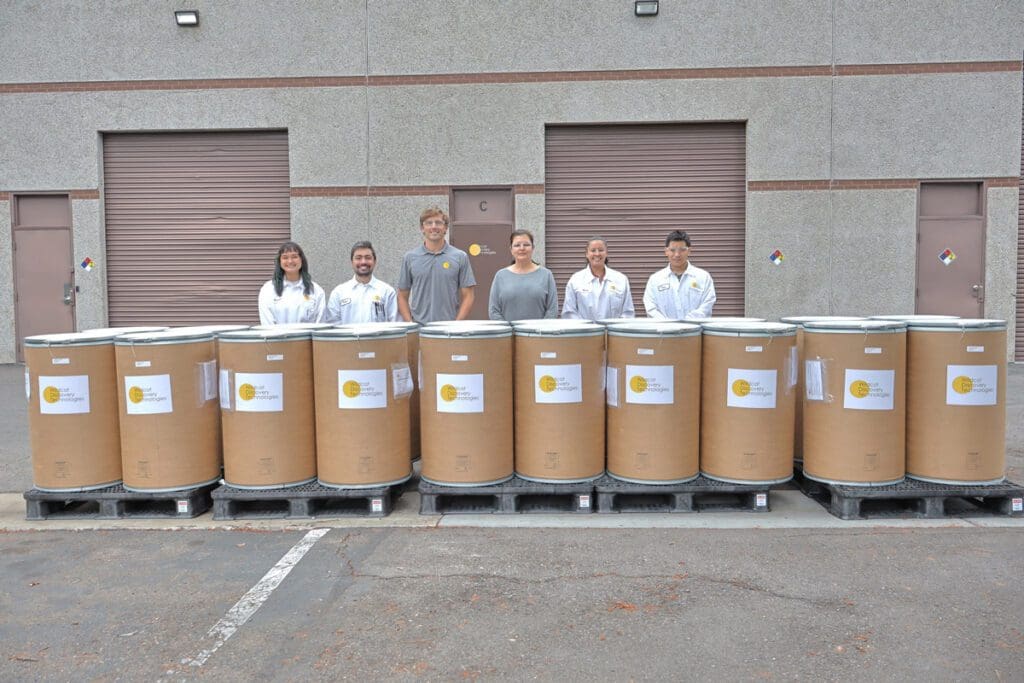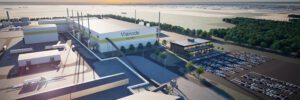
- Wildcat Discovery Technologies uses proprietary high-throughput testing platforms to rapidly evaluate battery materials and chemistries for customers. Now the company is building a US plant to produce nickel-free and cobalt-free cathode materials.
- Lithium iron phosphate (LFP) is considered a safer and longer-lasting cathode material compared to NMC chemistries, but in the past, its lower cell-level energy density made it less attractive for EVs. Now, manufacturers have taken advantage of LFP’s lower fire risk to design batteries with high pack-level energy density, and LFP has become the EV industry’s fastest-growing cathode material.
- LMFP is a version of LFP in which some of the iron is replaced by manganese. It offers similar performance, but manganese is very cheap, and it operates at a higher voltage, which enables a significant increase in energy density.
- Wildcat is working on an even newer cathode material called DRX. The company is building a plant in the US where it will produce LFP as it gradually phases in production of LMFP and DRX.
Q&A with Wildcat President and CEO Mark Gresser.
EV battery technology is advancing rapidly—it seems like every few days we read about a scientific breakthrough that will enable safer, cheaper, smaller and more energy-dense batteries. However, the road from the lab to the auto dealership is a long one—it typically takes several years of testing and development before a new battery technology is ready to be incorporated into production vehicles.
Wildcat Discovery Technologies, which has been developing battery materials since 2006, specializes in accelerating this process. The company uses proprietary high-throughput synthesis and testing platforms to rapidly evaluate thousands of materials and chemistries, and it partners with customers to develop customized battery cells for specific applications.
Recently, Wildcat has shifted its strategy—the company will become a producer of cathode materials, while continuing its research and engineering activities. Last December, Wildcat announced plans to build a US plant to produce a portfolio of nickel-free and cobalt-free cathode materials.
Charged spoke with Wildcat President and CEO Mark Gresser about his company’s plans, and the multiple advantages of its new cathode designs.
Charged: When we spoke back in 2021, you were working on an EV Supercell that featured a new type of cathode, a solid electrolyte and a lithium metal anode. What’s been happening at Wildcat since then?
Mark Gresser: Over the last few years, cell makers in North America have been looking for accessible, long-term alternatives to China-based CAM production. That’s why we’re shifting our strategy. Our new mission is to produce high-performance US-made cathode materials to enable widespread adoption of clean energy.
The cathode material you and I discussed in 2021 has been advancing very rapidly. We looked at what the industry needed and where we had opportunity, and realized that our DRX cathode was really the star of the show.
The DRX cathode, as we call it, stands for disordered rock salt. It is a high-energy, no-nickel, no-cobalt product that is going to compete really well with all the high-nickel materials that are in the industry now. We’re not quite ready to launch it today, but we’re getting close enough that we want to scale, and we’re seriously thinking about how and where we’re going to manufacture it right here in the United States.
It turns out the process and equipment we use to make DRX is shared with other cathode materials like lithium iron phosphate. So, if we’re going to build a plant in the US to make the DRX material, we could manufacture LFP in the same facility.
LFP is becoming the fastest-growing cathode material in the world, and it’s made almost exclusively in China today. Given the current climate and the desire of our customers to have a more localized supply chain, we’ve decided to expand our strategy. In the near term, we will produce LFP and be one of the first US producers of a really fast-growing cathode material. Then we can use the same suite of equipment and the same process steps to produce both LFP and our new DRX material.
Then in between those two materials is a manganese-rich version of LFP called LMFP. We’re getting lots of customer inquiries about LMFP, so we are developing recipes for that product as well. The overall plan for Wildcat is to produce a family of products that covers the whole spectrum of EV and stationary storage needs, here in the US.

Charged: Can you dig a little deeper into how the development of DRX cathode happened, and the advantages of it?
Mark Gresser: We started investigating disordered rock salt around 2015. We put a small team on it, as we’re apt to do here at Wildcat, using our high-throughput technology. Our scientists found some interesting compositions that looked really promising, so we started filing some patents. We’ve got some great patent coverage on that technology, and that’s our foundational IP.
One of our partners in this work is CBMM. They’re a big mining concern in South America, and they can supply some of the metals we use in the product. BMW has shown interest in this technology, and we announced a joint development agreement with them a couple of years ago. They’re providing technical support, they’re doing testing, they’re actively involved in bringing DRX to commercial readiness.
Here at Wildcat, we’ve been continually increasing the resourcing on this project. There are 50 Wildcat people now working on this project exclusively, and we’ve got a partnership with McGill University, with a really sharp team led by Professor Jinhyuk Lee.
We see DRX as a breakthrough for the battery industry. From a performance standpoint, it’s made from mostly abundant and available low-cost materials. No nickel, no cobalt. The material has the potential to be about 20% more energy-dense than the high-nickel materials that are finding their way into the market now.
We also see the potential for a big safety advantage. The material performs very well in our early safety testing. We have more to do on the testing, but it looks like this is going be a clean, safe, higher-energy, low-cost material for the high end of the EV market.
“We see DRX as a really big deal for the battery industry. No nickel, no cobalt. It looks like this is going be a clean, safe, higher-energy, low-cost material for the high end of the EV market.”
Charged: Of those bullet points of advantages, would you say the low cost of the materials is the top one?
Mark Gresser: It’s certainly one of the top three—of course, depending on who we speak with. For some, the higher energy is pretty compelling, and then safety, as you know, is critical. We’re not quite ready to market it today because we’re still developing the material. We think it needs another two years before we’re ready to start shipping samples to customers, but certainly low cost on a $/kWh basis will be critical.
Charged: Can you break down the difference between LFP and LMFP?
Mark Gresser: LFP—lithium iron phosphate—has been around a long time. It’s one of the oldest of the cathode materials, but it was deemed to be not energy-dense enough for EVs.
However, about three years ago something changed. Some clever engineering from Chinese manufacturers took advantage of the safety of the material and designed packs that were much lighter.
And when you factor in the lower cost of LFP packs, there is a growing market. Many have taken notice and LFP is now the fastest-growing cathode material out there.
LMFP is a manganese-rich version of LFP. You’re substituting a lot of manganese into the mix to replace some of the iron. A typical ratio of manganese to iron in that product is around 60:40. These products perform similarly, but manganese is very cheap, and it operates at a higher voltage. Because of that higher voltage, you can get about a 15% boost in energy density. The theory is you’re not really adding costs, but you’re adding energy.
The reality though, is that it’s not widely used yet. There are a number of companies saying they have LMFP ready to go, but much of the LMFP we’ve tested exhibits some shortcomings. We’ve found that most LMFP we test still doesn’t cycle like LFP. And there’s a few other small deficiencies.
We think there’s an opportunity to create a better version of LMFP, and so we’re working on this. We have a basic 60:40 manganese version in testing now that some key customers are evaluating. Based on their feedback, we’re pushing that LMFP to higher levels of manganese and better performance.
And then our DRX product is a great fit for anything needing a boost in energy—especially premium EVs. So, across our portfolio of three cathodes, we have a low-tech to high-tech spectrum, and a very large cross-section of applications.
“LMFP is a manganese-rich version of LFP. Manganese is very cheap, and it operates at a higher voltage. The theory is you’re not really adding costs, but you’re adding energy.”
Charged: Numerous EV industry execs have told Charged the “Buy American” provisions of the 2022 Inflation Reduction Act (IRA) are driving massive investments in domestic EV battery materials. How important is the IRA to your plan to manufacture materials in the US?
Mark Gresser: It is a big driver for our plan to go into manufacturing. We want to scale and produce DRX material because the value proposition for that is great. It’s patent-protected, it offers higher energy, lower cost, better safety. It checks all the boxes. However, the product isn’t ready to commercialize today. So when the IRA came around, we realized that we could get to scale more quickly by manufacturing multiple cathodes via the same process, which led us to the LFP/LMFP strategy.
For a globally produced product like LFP, the IRA is critical. Otherwise, it would be difficult to set up a plant and compete directly with Chinese manufacturers. Right now, there’s significant overcapacity in China, and when there’s overcapacity, they drop pricing quickly. The IRA tax incentives coupled with tariffs protect US manufacturers and offer an important opportunity to invest in manufacturing.
We designed our US plant to keep costs very low. It’s a very automated plant, and a well-engineered process, so we can compete apples-to-apples with anybody.
“For a globally produced product like LFP, the IRA is critical. Otherwise, it would be difficult to set up a plant and compete directly with Chinese manufacturers”
Charged: When you say a hundred percent IRA compliant, that means all your base materials are coming from approved countries. Are those supply chains already in place or are they being built at the same time as you’re ramping up?
Mark Gresser: Supply chains don’t really fully exist in the US or in compliant countries yet—they’re being built. We’re at one place in the supply chain—we’re making cathode powder and selling to cell makers. But then further upstream from us, you’ve got people making the precursor materials that we use to make our cathode material. We’ve got a lot of MOUs in place with lithium providers, so we don’t think that’ll be a problem.
When you look at building a US-based supply chain for EVs, you have to look at the whole supply chain. You have to go all the way back to the mined materials and make sure that the US is also supporting the development of critical mineral supplies here in North America, and I think our Department of Energy is doing this well.
Charged: Do you have any concern about the IRA being rolled back?
Mark Gresser: We talk a lot with the politicians, the DOE, and other stakeholders about this issue. The sense we get is that the EV supply chain in the US has become a fairly bipartisan issue.
US-made batteries mean energy independence. It’s a key technology for the future, and it isn’t just the passenger vehicle market. It’s trucks, shipping, military applications. Having the ability to produce high-tech batteries in the US and do the R&D for those batteries in the US, we think that puts Wildcat in a pretty good spot. If you combine that with cathode production here in the US, that’s a situation that is not reliant on any kind of foreign partnership, and serves the US well.
“We talk a lot with the politicians, the DOE, and other stakeholders, and the sense we get is that the EV supply chain in the US has become a fairly bipartisan issue.”
Charged: If the IRA sticks around, I think it might be one of the most impactful pieces of legislation ever in terms of US manufacturing. The amount of activity that I see every day is insane.
Mark Gresser: I was just putting together a slide for a presentation—it was about the number of gigafactory announcements in the US pre- and post-IRA. There’s something like 43 gigafactories that have been announced, and the IRA is a major driver. We’re literally creating a new auto industry and it’s all US-based, which is terrific.
Charged: What’s up with the legacy Wildcat business? Are you guys still doing that in parallel with this?
Mark Gresser: Yes. We’ve got this incredible high-throughput R&D capability, and over the past couple of years, we’ve continued to take that to the next step, from basic R&D to starting to scale. We’ve put in all types of equipment that allows us to make small and large pouch cells right here at Wildcat. We’ve got two dry rooms. We’ve got coaters to produce anodes and cathodes. We’ve got a huge slot dye coater for our big cells. We’ve got all the equipment we’re going to use in production at a pilot scale here in San Diego.
When you think about customer evaluations, the typical process for cathode makers is to ship a powder to a cell maker or an automaker, and then wait for months, sometimes even a year, to get feedback. You’re waiting for them to turn that material into a slurry, make a film, build a battery and then cycle the battery. You’re asking your customers to provide all that work, and that’s a lot of time and money for them.
So, imagine how much we can accelerate the adoption cycle for our products because we don’t have to ask our customers to do all the work of evaluating a new material. And we take it one step further—if they decide they’re going to use our LFP or our LMFP, we can execute a benchmark project like those we offer to our legacy customers, where we start with the Wildcat cathode, evaluate dozens of anodes, and then tailor multiple different electrolyte formulations to work best with that anode/cathode pair. And we can present all that to our customer and say, “If you’re going to buy the Wildcat cathode material, we’ll help you design the whole cell and optimize its performance.”
“We can accelerate the adoption cycle for our products because we don’t have to ask our customers to do all the work of evaluating a new material. If you’re going to buy Wildcat cathode material, we’ll help you design the whole cell and optimize its performance.”
Charged: You’re aiming to produce LFP material in 2026.
Mark Gresser: We plan to have the plant stood up in Q4 2026.Of course, selling product will happen later in 2027. Our plan is to produce cathode powder. We’ll be shipping that to cell makers. And it goes beyond EVs—LFP is the material of choice for stationary storage, which is becoming another big market, and we’re already sampling with customers in this space.
Charged: How’s the progress on the new plant? Have you announced the location?
Mark Gresser: We’re making large quantities of material for customer sampling, but that’s from our San Diego demonstration line. In fact, we recently produced one metric ton of LFP cathode material, which demonstrated our capacity for large-scale production. We’re sharing it with customers for sampling, and feedback has been very positive.
For the new plant, we’ve got an engineering firm on board, and they are in the final phase of designing the plant. We hired top experts to lead our manufacturing team. We’re actively raising capital now, and looking for key strategic partners to go to the plant scale. We’re telling folks that the plant will be in the battery belt in the Southeast of the US, but we haven’t made a formal location announcement yet.
We’re going to keep the R&D headquarters in San Diego—there’s a couple of reasons for that, and one is access to talent. California is a great place to access scientific talent—the value of the labor pool here outweighs any cost disadvantages. But when it comes to large-scale manufacturing, we have to be cognizant of utility prices in California vs other states, and for us, utility cost is one of the main drivers for our decision on location.
We are excited about Wildcat’s future. Our vision is to be the first choice for battery materials development, integration, and supply—and we have the strategy, expertise, innovation, and best team in the industry to make it happen.
from Charged EVs https://ift.tt/3wo56xN


No comments:
Post a Comment